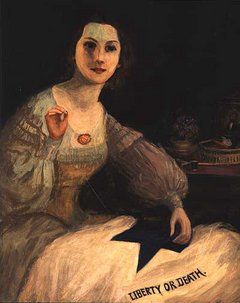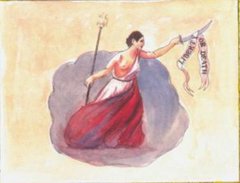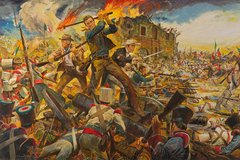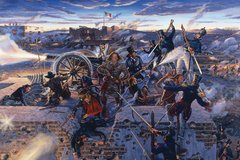In the Texas Revolution, as in other revolutions both contemporary and historical, imagery played an important role in instilling a sense of revolutionary spirit. As the men of Texas organized into various militias, the women of Texas went to work designing and sewing flags for them to march under. Many of the flag makers of the Texas Revolution are unknown. Newspaper and eyewitness accounts of the presentation of flags to various companies often only noted that the flags were presented by local women, but neglected to name the female presenters. In several cases, however, the contributions of individual women to the design and manufacture of the Texian’s colors are well known. Here are a few of their stories.
Flag Makers of the Texas Revolution

The “Come and Take It Flag” produced following the Battle of Gonzales is probably the most recognizable of all of the flags of the Texas Revolution. Noah Smithwick, who marched with the flag from Gonzales to Bexar in October of 1835 called the flag the Old Cannon Flag and described it as “a breadth of white cotton cloth about six feet long, in the center of which was painted in black a picture of the old cannon, above it a lone star and beneath it the words ‘Come and Take it.’” This flag is typically credited as the work of Evaline DeWitt, daughter of the Empresario Green DeWitt, and Cynthia Burns, a female resident of the DeWitt Colony.

Just as not all of the men who fought in the Texas Revolution were Texas citizens, neither were all of the flag makers. As news of the revolution began to spread throughout the United States, companies of men formed in several southern states, including Georgia where a battalion was formed by William Ward. Joanna Troutman, a young lady in Crawford County, Georgia who may have been romantically involved with one of the men in Ward’s newly formed battalion, made the flag that the Georgia men carried to Texas. The Troutman flag was made of white silk with a blue star with the words “Liberty or Death” printed below the star. The Troutman flag was raised in Goliad by James Walker Fannin and flew over the presidio there for a time until it was destroyed by the wind.

Of the flag makers of the Texas Revolution, arguably Sarah Bradley Dodson had the most remarkable experience during the war. At age eleven Sarah, daughter of Edward Bradley, immigrated to Texas from Kentucky with her family in 1822 as part of Austin’s Old 300. On May 17, 1835 on the eve of the revolution, Sarah married Archelaus Dodson, a resident of Harrisburg and immigrant from North Carolina. In September of 1835, Archelaus joined the newly formed Harrisburg company as the company’s First Lieutenant. Sarah designed and sewed a flag for her husband’s company. The Dodson flag was made out of calico and was three horizontal squares or rectangles of red, white and blue with a white star in the center of the blue square.
The Harrisburg Company marched under the Dodson flag to Bexar where the flag was reportedly flown during the Battle of Concepcion. The Dodson flag, along with the Dimitt or Brown flag, was also reportedly flown over the cabin in Washington-on-the-Brazos where the Convention of 1836 met. During the Runaway Scrape, Archelaus Dodson was assigned to aid women and children in crossing the Brazos River. It was in a makeshift refugee camp on the banks of this river on April 9, 1836 that Sarah gave birth to the couple’s first child. Following the war the Dodsons settled along the river in present day Ft. Bend County for a time before relocating to Grimes County. What became of the flag Sarah made is unknown.

In fact, most of the flags carried by the Texians during the revolution have not survived to present day. One of the few flags to survive was the San Jacinto battle flag, which today is displayed in the Texas House of Representatives chamber. Like the Troutman flag, this flag was brought to Texas by a group of American volunteers, this time a company from Kentucky. The flag was made by a group of local women and presented to the Newport Rifle Company by Katherine Sherman, wife of the company’s Captain. Following the war, the flag was presented back to Mrs. Sherman and was kept in the family until 1896 when the couple’s daughters gifted the flag back to the people of Texas.
The flags of the Texas revolution have long since faded or been destroyed, but the messages of liberty and independence that they contained continue to the present day. Not only are modern reproductions of these flags common sights in the state, the state flag is clearly inspired by these earlier wartime banners.
Bibliography
Cox, Mamie Wynne, The Romantic Flags of Texas (Dallas: Banks Upshaw, 1936).
The Descendants of Austin’s Old Three Hundred. Austin’s Old Three Hundred Austin: Eakin Press, 1999.
Mayberry, Robert, Jr. Texas Flags. College Station: Texas A&M University Press, 2001.
Smithwick, Noah. The Evolution of a State, or Recollections of Old Texas Days Austin: Gammel, 1900; rpt., Austin: University of Texas Press, 1983.
Spain, Charles A. Jr., “FLAGS OF THE TEXAS REVOLUTION,” Handbook of Texas Online, accessed September 27, 2014. Uploaded on June 12, 2010. Modified on February 11, 2011. Published by the Texas State Historical Association.


